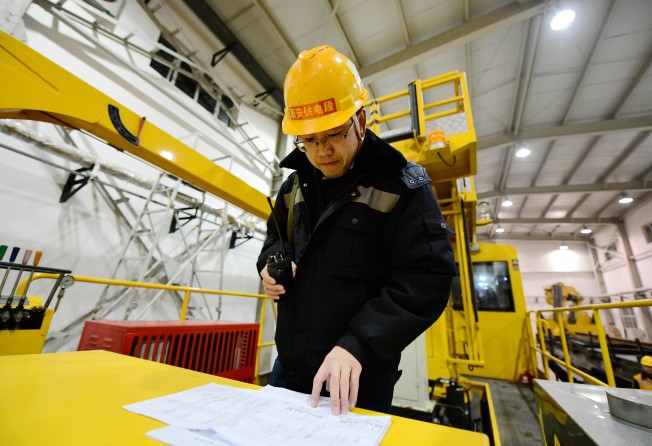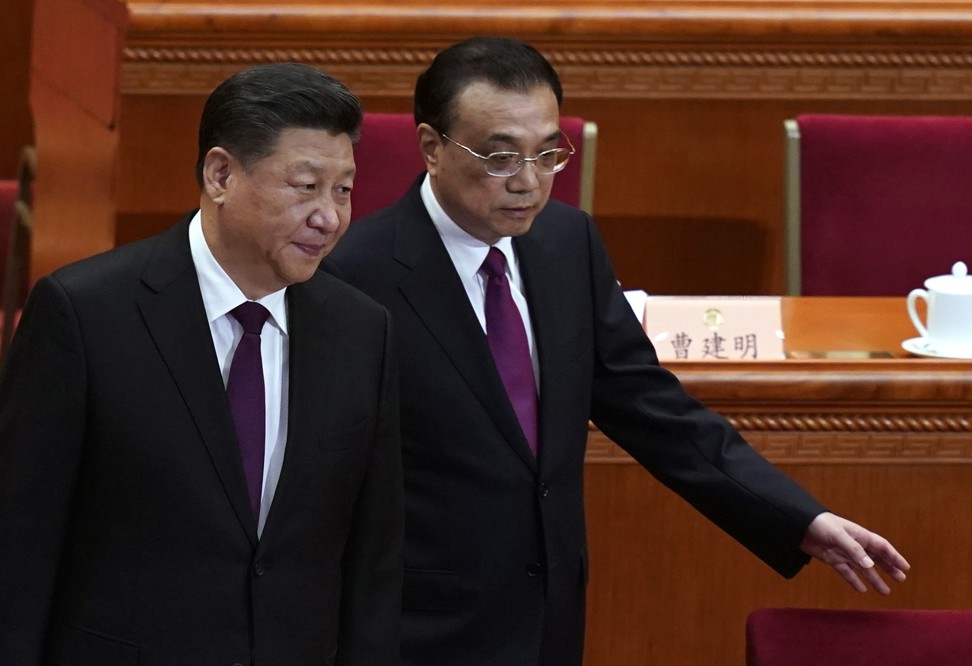China raises 2019 budget deficit target on promises of tax cuts and infrastructure spending to stem slowdown
- Deficit target raised to 2.8 per cent of gross domestic product from 2.6 per cent in 2018, providing more fiscal leeway for government spending
- Business and personal taxes to be cut by 1.3 trillion yuan (US$194 billion), more than the 1.1 trillion yuan in cuts last year, Premier Li Keqiang said on Tuesday

China’s government has lifted its 2019 budget deficit target to 2.8 per cent of gross domestic product from last year’s 2.6 per cent, giving Beijing more room to step up tax cuts and increase infrastructure spending to stabilise its sagging economy, Premier Li Keqiang said in his annual work report on Tuesday.
The government will pursue a “proactive” fiscal policy “with greater intensity,” Li said, while maintain a prudent monetary policy that avoids excess stimulus to the economy.
The government will increase infrastructure spending and pursue a series of business tax cut, particularly aimed at supporting smaller firms that are struggling with the effects of the government deleveraging campaign to reduce debt and risky lending.
Business and personal taxes will be cut by 1.3 trillion yuan (US$194 billion) this year, more than the 1.1 trillion yuan in last year’s cuts, the premier said.
“Our moves to cut taxes on this occasion aim at an accommodative effect to strengthen the basis for sustained growth while also considering the need to ensure fiscal sustainability; are a major measure to lighten the burden on businesses and boost market dynamism; … and are the result of a major decision taken at the macro policy level in support of the efforts to ensure stable economic growth, employment, and structural adjustments,” Li said, according to an official English-language version of this speech.
The government will cut the value-added tax rate for manufacturing firms from 16 per cent to 13 per cent and reduce the rate for transport and construction firms from 10 per cent to 9 per cent, Li said.
To help small technology businesses, the threshold for application of the value-added tax (VAT) will be raised to 100,000 yuan (US$14,914) from 30,000 yuan.
Li also renewed the government’s promise, first made last year, to simply the VAT tax system and reduce the number of tax brackets from three to two.
China will also cut the contribution rate for government pension insurance that employers must pay for each worker to 16 per cent from the current range of between 19 and 20 per cent.
Li also sought to address one of the biggest complaints among small businesses – that stricter collection of social tax payments starting this year would significantly increase their costs and potential put some of them out of business.
“The social insurance premium collection methods currently in operation will remain unchanged. No locality should take any measure that increases the burden on small and micro enterprises when reforming their collection systems, or require, on their own, that long-standing arrears be paid off in a lump sum.”
Including the cut in the social security contribution rate, total tax cuts this year would amount to 2 trillion yuan (US$298 billion), Li said.
Analysts have expected that China would be more active in fiscal measures while keeping monetary policy prudent to cushion impact from a slowing economy and the trade war with the United States.
Yan Se, associate professor at the Guanghua School of Management at Peking University has said that 2.8 per cent is a reasonable target for the government budget deficit given the imperative to stabilise debt growth.
“Never doubt or underestimate China’s determination and will to stabilise growth and prevent risks,” Yan said at a seminar last week about China’s National People’s Congress.
“We believe that steady growth and risk prevention are the focus of this year.”
Analysts at Morgan Stanley believe that, in practise, the government’s fiscal leeway will be larger than indicated by the official budget deficit target.
“Taking transfer from fiscal reserves and off-budget items into account, we expect the augmented fiscal deficit to widen by 1.5 percentage points of [gross domestic product],” Morgan Stanley said in a report on Friday.
To help the rising number of unemployed, the government will give a three-year tax holiday for each person who has been out of work for more than six months, Li said.
In addition, the government has set a 2.15 trillion yuan (US$320 billion) limit for issuing special-purpose local government bonds this year, 800 billion yuan (US$119 billion) more than the 1.35 trillion yuan issued last year.

Special purpose bonds are used by local authorities to fund infrastructure investment, a key element of the Chinese government’s economic stimulus plan.
Government investment goals for this year include 800 billion yuan (US$119 billion) for railway investment, 1.8 trillion yuan (US$268 billion) for motorways and waterways, as well as 578 billion (US$86 billion) for telecommunications upgrades.
Last year, the Chinese premier said that the government had strengthened management over local government debt, and issued local government bonds to replace outstanding debt, cutting interest liabilities by 1.2 trillion yuan and the deficit-to-gross domestic product ratio within 3 per cent.
Policymakers have pledged to step up support for the cooling economy this year, following a series of 2018 measures that included fast-tracking infrastructure projects and reducing banks’ reserve requirements, as well as cuts in business and individual taxes.